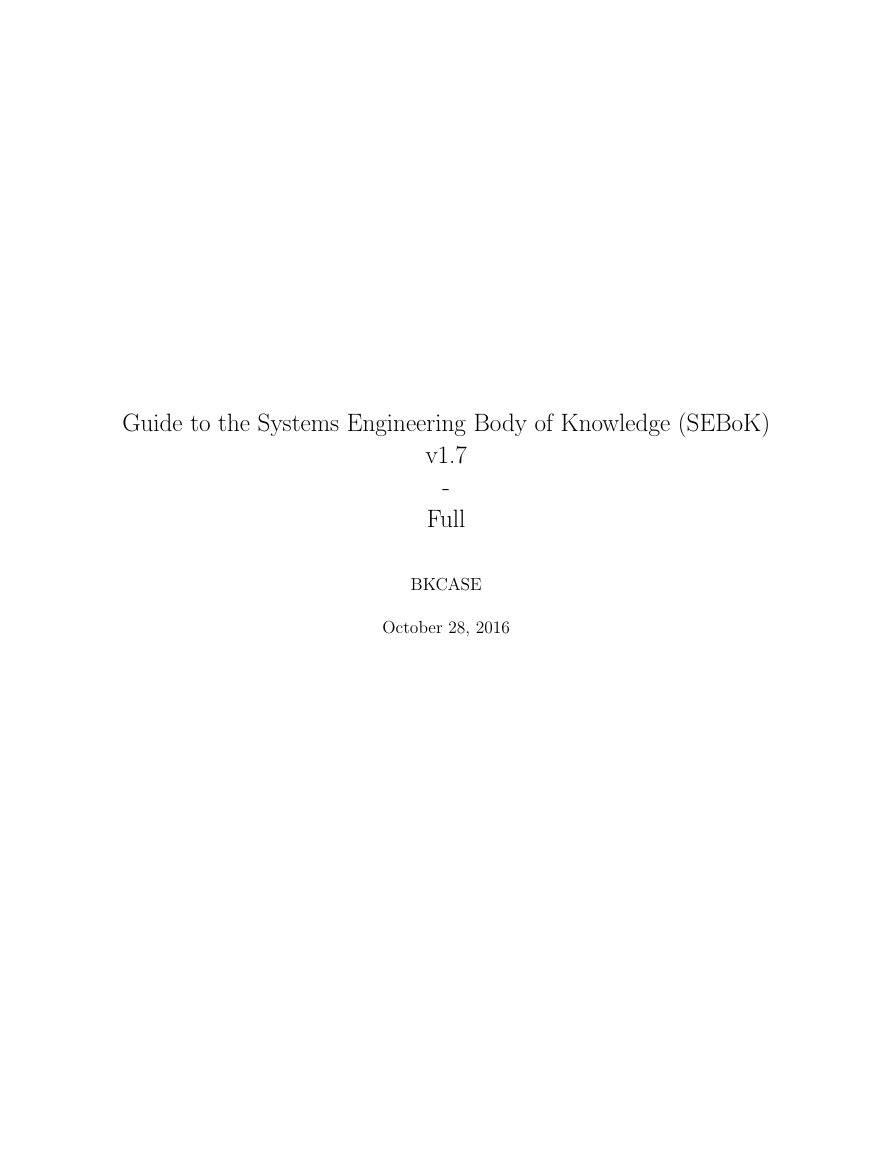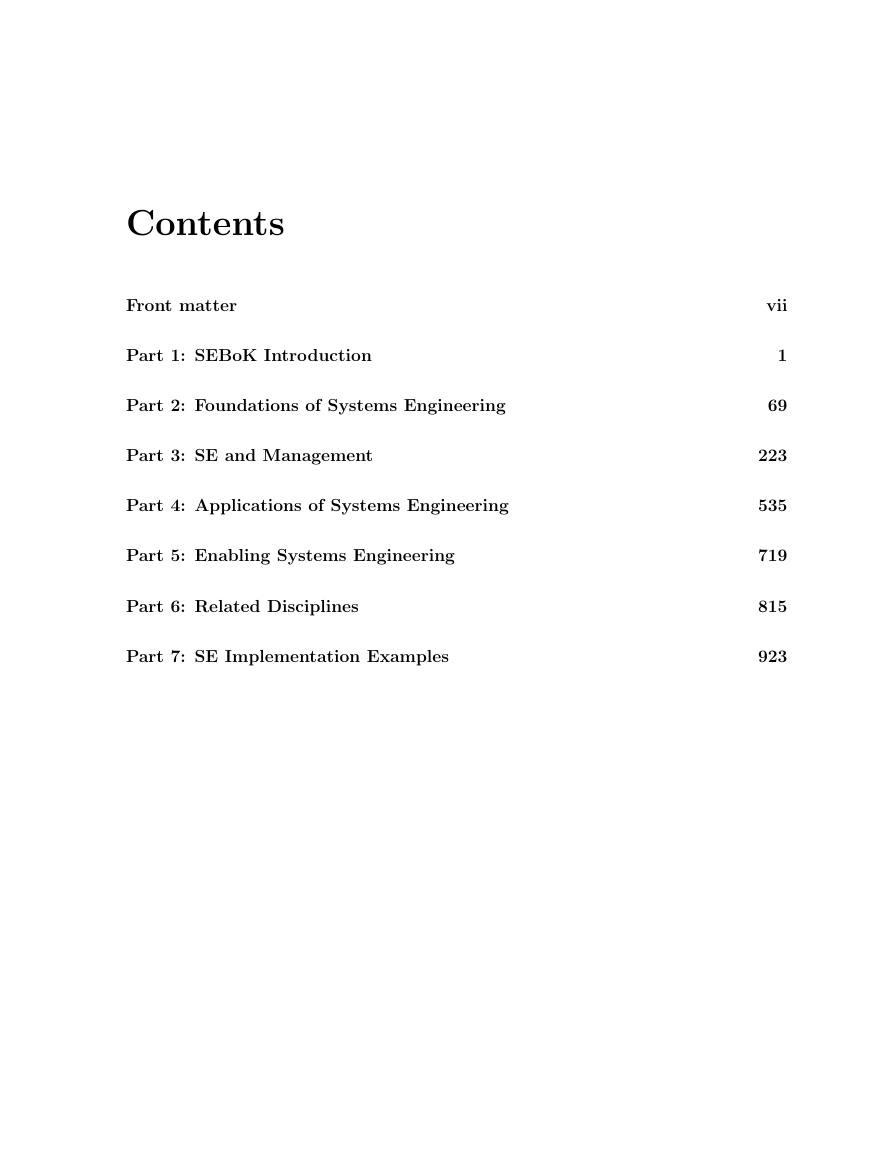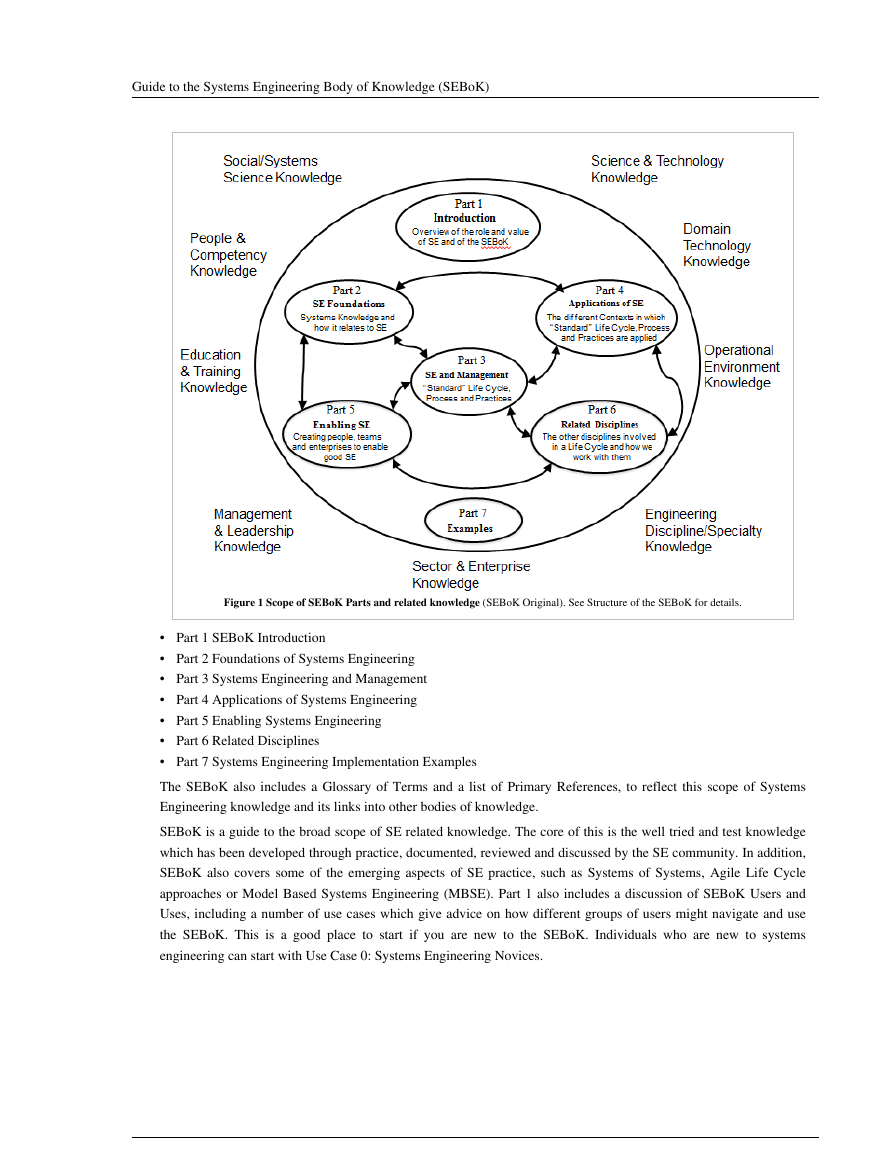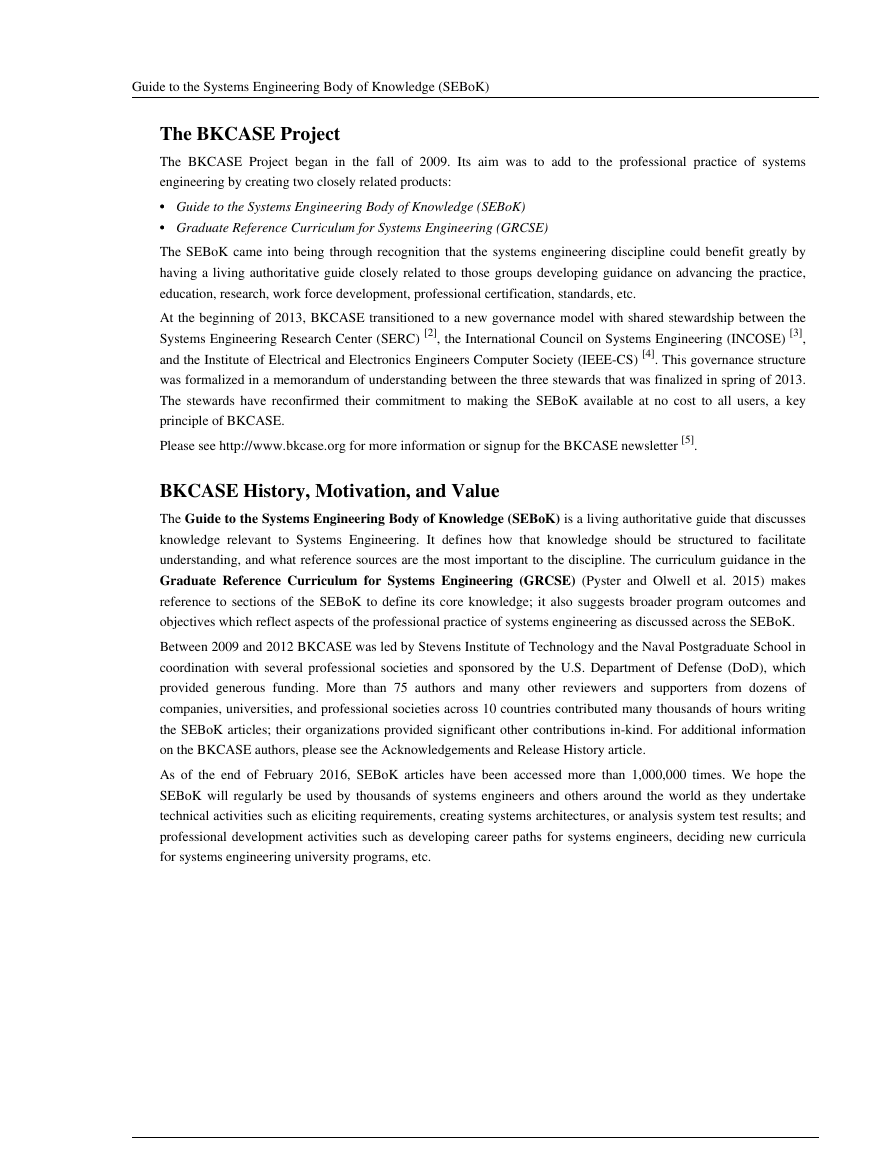Guide to the Systems Engineering Body of Knowledge (SEBoK)
v1.7
-
Full
BKCASE
October 28, 2016
�
�
Contents
Front matter
Part 1: SEBoK Introduction
Part 2: Foundations of Systems Engineering
Part 3: SE and Management
Part 4: Applications of Systems Engineering
Part 5: Enabling Systems Engineering
Part 6: Related Disciplines
Part 7: SE Implementation Examples
vii
1
69
223
535
719
815
923
�
�
Cover
�
�
Guide to the Systems Engineering Body of Knowledge (SEBoK)2Figure 1 Scope of SEBoK Parts and related knowledge (SEBoK Original). See Structure of the SEBoK for details.•Part 1 SEBoK Introduction•Part 2 Foundations of Systems Engineering•Part 3 Systems Engineering and Management•Part 4 Applications of Systems Engineering•Part 5 Enabling Systems Engineering•Part 6 Related Disciplines•Part 7 Systems Engineering Implementation ExamplesThe SEBoK also includes a Glossary of Terms and a list of Primary References, to reflect this scope of SystemsEngineering knowledge and its links into other bodies of knowledge.SEBoK is a guide to the broad scope of SE related knowledge. The core of this is the well tried and test knowledgewhich has been developed through practice, documented, reviewed and discussed by the SE community. In addition,SEBoK also covers some of the emerging aspects of SE practice, such as Systems of Systems, Agile Life Cycleapproaches or Model Based Systems Engineering (MBSE). Part 1 also includes a discussion of SEBoK Users andUses, including a number of use cases which give advice on how different groups of users might navigate and usethe SEBoK. This is a good place to start if you are new to the SEBoK. Individuals who are new to systemsengineering can start with Use Case 0: Systems Engineering Novices.�
Guide to the Systems Engineering Body of Knowledge (SEBoK)3The BKCASE ProjectThe BKCASE Project began in the fall of 2009. Its aim was to add to the professional practice of systemsengineering by creating two closely related products:••Guide to the Systems Engineering Body of Knowledge (SEBoK)••Graduate Reference Curriculum for Systems Engineering (GRCSE)The SEBoK came into being through recognition that the systems engineering discipline could benefit greatly byhaving a living authoritative guide closely related to those groups developing guidance on advancing the practice,education, research, work force development, professional certification, standards, etc.At the beginning of 2013, BKCASE transitioned to a new governance model with shared stewardship between theSystems Engineering Research Center (SERC) [2], the International Council on Systems Engineering (INCOSE) [3],and the Institute of Electrical and Electronics Engineers Computer Society (IEEE-CS) [4]. This governance structurewas formalized in a memorandum of understanding between the three stewards that was finalized in spring of 2013.The stewards have reconfirmed their commitment to making the SEBoK available at no cost to all users, a keyprinciple of BKCASE.Please see http:/ / www. bkcase. org for more information or signup for the BKCASE newsletter [5].BKCASE History, Motivation, and ValueThe Guide to the Systems Engineering Body of Knowledge (SEBoK) is a living authoritative guide that discussesknowledge relevant to Systems Engineering. It defines how that knowledge should be structured to facilitateunderstanding, and what reference sources are the most important to the discipline. The curriculum guidance in theGraduate Reference Curriculum for Systems Engineering (GRCSE) (Pyster and Olwell et al. 2015) makesreference to sections of the SEBoK to define its core knowledge; it also suggests broader program outcomes andobjectives which reflect aspects of the professional practice of systems engineering as discussed across the SEBoK.Between 2009 and 2012 BKCASE was led by Stevens Institute of Technology and the Naval Postgraduate School incoordination with several professional societies and sponsored by the U.S. Department of Defense (DoD), whichprovided generous funding. More than 75 authors and many other reviewers and supporters from dozens ofcompanies, universities, and professional societies across 10 countries contributed many thousands of hours writingthe SEBoK articles; their organizations provided significant other contributions in-kind. For additional informationon the BKCASE authors, please see the Acknowledgements and Release History article.As of the end of February 2016, SEBoK articles have been accessed more than 1,000,000 times. We hope theSEBoK will regularly be used by thousands of systems engineers and others around the world as they undertaketechnical activities such as eliciting requirements, creating systems architectures, or analysis system test results; andprofessional development activities such as developing career paths for systems engineers, deciding new curriculafor systems engineering university programs, etc.�
















 2023年江西萍乡中考道德与法治真题及答案.doc
2023年江西萍乡中考道德与法治真题及答案.doc 2012年重庆南川中考生物真题及答案.doc
2012年重庆南川中考生物真题及答案.doc 2013年江西师范大学地理学综合及文艺理论基础考研真题.doc
2013年江西师范大学地理学综合及文艺理论基础考研真题.doc 2020年四川甘孜小升初语文真题及答案I卷.doc
2020年四川甘孜小升初语文真题及答案I卷.doc 2020年注册岩土工程师专业基础考试真题及答案.doc
2020年注册岩土工程师专业基础考试真题及答案.doc 2023-2024学年福建省厦门市九年级上学期数学月考试题及答案.doc
2023-2024学年福建省厦门市九年级上学期数学月考试题及答案.doc 2021-2022学年辽宁省沈阳市大东区九年级上学期语文期末试题及答案.doc
2021-2022学年辽宁省沈阳市大东区九年级上学期语文期末试题及答案.doc 2022-2023学年北京东城区初三第一学期物理期末试卷及答案.doc
2022-2023学年北京东城区初三第一学期物理期末试卷及答案.doc 2018上半年江西教师资格初中地理学科知识与教学能力真题及答案.doc
2018上半年江西教师资格初中地理学科知识与教学能力真题及答案.doc 2012年河北国家公务员申论考试真题及答案-省级.doc
2012年河北国家公务员申论考试真题及答案-省级.doc 2020-2021学年江苏省扬州市江都区邵樊片九年级上学期数学第一次质量检测试题及答案.doc
2020-2021学年江苏省扬州市江都区邵樊片九年级上学期数学第一次质量检测试题及答案.doc 2022下半年黑龙江教师资格证中学综合素质真题及答案.doc
2022下半年黑龙江教师资格证中学综合素质真题及答案.doc